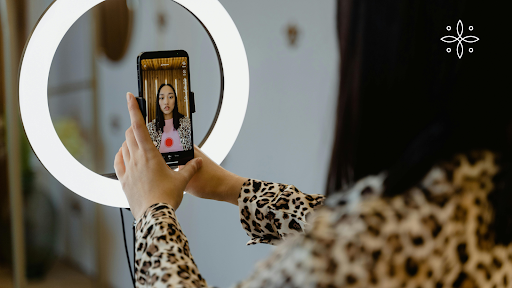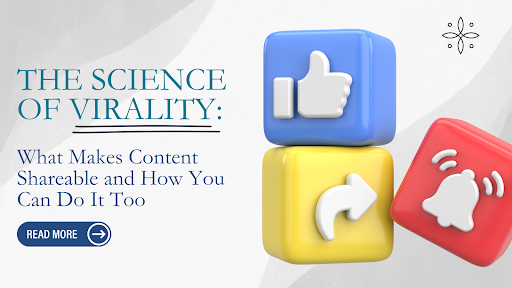- Viral content follows a pattern—it spreads due to exposure, emotional impact, and shareability.
- People share content that entertains, educates, or helps them connect with others.
- Combining SEO with viral strategies keeps content relevant and discoverable over time.
The internet is flooded with content, but only a small fraction goes viral. Whether it’s a meme, a tweet, or a marketing campaign, viral content follows patterns that make people click, engage, and share. But what exactly makes content go viral? Is it luck, strategy, or a mix of both?
Here we explore the science behind viral content and how you can use these principles to create posts, videos, and campaigns that generate a buzz.
What Makes Content Go Viral?
Virality isn’t random—it follows a predictable formula. By understanding how exposure, emotions, and shareability work together, you can create content that can quickly become popular.
The Formula for Virality
At its core, viral content has three key ingredients:
- Exposure: This explains the number of people who see the content. The more eyeballs your content gets, the better its chances of going viral. This is why social media algorithms, influencers, and strategic distribution matter. It won’t gain momentum if your post doesn’t reach enough people initially.
- Emotion: Does your post trigger a strong reaction? Viral content makes people feel something deeply—whether it’s laughter, shock, or inspiration. If a post doesn’t create an emotional response, people won’t feel compelled to share it.
- Shareability: Is your post easy and rewarding to share? The easier it is to share content, the more likely it is to spread. Bite-sized, visually engaging, and easily relatable posts perform well because people can quickly repost them.
The Role of Social Proof & Network Effects
Social proof plays a huge role in virality. People are more likely to engage with content if they see others doing the same.
- Likes, comments, and shares act as endorsements. If a post already has thousands of shares, others assume it must be worth reading.
- Influencers and celebrities can amplify content. A single reshare from a big name can skyrocket a post’s visibility.
- Communities drive engagement. Content that sparks discussions in Facebook groups, Reddit threads, or niche forums has a higher chance of spreading.
This is why brands often collaborate with influencers or run engagement-boosting campaigns—it creates an initial wave of interaction, making it more likely for content to go viral.
The Importance of Timing & Trends in Virality
Even the best content can flop if posted at the wrong time. Timing is crucial for virality because:
- Trending topics get priority on social media. If your content ties into current events, viral challenges, or seasonal themes, it has a better chance of taking off.
- Peak posting times boost engagement. Different platforms have different prime times. For example, Twitter engagement is highest in the morning, while Instagram posts do better in the evening.
- Reacting fast to trends is key. If a meme or cultural moment is gaining traction, acting quickly can help your content ride the wave before it dies down.
A great example is the #IceBucketChallenge—a perfect mix of timing, emotion, and social proof that spread worldwide in record time.
What Makes Content Shareable? The Psychology Behind Virality
Understanding why people share content is key to making your content go viral. It all comes down to psychology—what emotions, needs, and social behaviors drive people to hit the “share” button? Let’s find out!
Emotional Reactions Drive Shares
Emotion plays a huge role in virality. Studies show that content that triggers strong emotions (both positive and negative) gets more shares.
- Positive emotions (awe, joy, inspiration) encourage people to share uplifting content.
- Negative emotions (anger, surprise, fear) make people react strongly and engage more.
For example, inspiring success stories or heartwarming reunions tend to go viral because they spark joy and connection. On the other hand, controversial debates or shocking news spread fast because they provoke outrage and curiosity.
Social Currency
People share content that makes them look good to others. If a post makes them seem funny, intelligent, or “in the know,” they are more likely to pass it along. This is why life hacks, industry secrets, and breaking news often go viral—they give people something valuable to share.
Practical Value
Useful content spreads fast. Whether it’s “10 Productivity Hacks” or “The Best Free Tools for Small Businesses”, people love sharing helpful information. How-to guides, tutorials, and lists are a great example of this. If your content solves a problem, it’s more likely to be shared.
Relatability
People connect with content that reflects their daily struggles, dreams, or humor. This is why memes, personal anecdotes, and relatable tweets gain traction. For example, a post that says “If you hit snooze 5 times every morning, we’re the same person” will resonate with many, making them more likely to share it.
Social Validation
Humans are social creatures. One of the biggest reasons people share content is to connect with others—whether it’s to entertain friends, express their opinions, or be part of a conversation. Naturally, personal, authentic content tends to perform well as it makes people feel heard and understood.
Storytelling
Facts are easy to forget, but stories stick. Content that follows a story arc—with a problem, struggle, and resolution—captures attention and increases engagement. This is why brands that tell compelling stories in their marketing (like Nike or Coca-Cola) see higher engagement and shares.
The Key Elements of Viral Content
Not all content has the potential to go viral. To maximize your chances, your content needs specific elements that grab attention, spark engagement, and encourage sharing.
Let’s break down the most effective components.
Attention-Grabbing Headlines
Your headline determines whether people will click on your content or scroll past it. A great viral headline:
- Creates Curiosity: “You Won’t Believe What This Dog Did!”
- Promises Value: “5 Simple Tricks to Save Money on Groceries”
- Uses Numbers: “10 Habits of Highly Successful People”
If your headline doesn’t hook the reader immediately, your content won’t get the attention it deserves.
Easily Digestible and Visual Content
People prefer short, clear, and visual content. That’s why:
- Videos and GIFs go viral faster than text posts.
- Infographics get shared more than plain articles.
- Bullet points and short paragraphs make blogs easier to read (like this one!).
If your content is easy to consume, it’s more likely to be shared.
Interactive & User-Generated Content

Content that encourages participation is more likely to spread because it makes users feel involved rather than just passive viewers.
Examples of High-Engagement Interactive Content are:
- Polls & Quizzes: People love giving their opinions and seeing how they compare to others.
- Challenges & Trends: Viral challenges (like TikTok dance trends) invite people to join in and share their own versions.
- User-Generated Content (UGC): When people create their content inspired by yours, it naturally expands your reach. A brand launching a photo contest encouraging users to submit pictures featuring their product gets free exposure from every participant’s audience.
The Role of Humor
Funny posts are highly shareable because they entertain without asking for anything in return. Witty memes, sarcastic tweets & comments, and parodies & satirical videos are the best examples of humorous content.
Call to Action (CTA) Encouraging Shares
Sometimes, people need a little nudge to share your content. A simple “Tag a friend who needs to see this!” or “Share this with someone who loves coffee!” can increase engagement. Encouraging discussions in the comments can also lead to more visibility. Posts that ask a question or spark debate naturally get more shares.
How to Apply These Viral Strategies to Your Content
Now that we know the science behind virality, how can you apply these principles to your own content?
Optimize for Social Media Algorithms
Social media platforms prioritize content that keeps users engaged. To increase your chances of going viral:
- Encourage Engagement Early: Ask questions, use polls, and interact with comments.
- Post When Your Audience Is Active: Check your analytics and post during peak hours.
- Use Eye-Catching Thumbnails and Captions: A strong visual can make people stop scrolling.
Test Different Formats
Try different content formats to see what resonates with your audience. Videos, polls, carousels, and infographics often perform better than plain text posts. Experiment and track what works best.
Leverage Influencers and Communities
If you want fast traction, consider collaborating with influencers or niche communities. A retweet from an industry expert or a shoutout in a popular group can boost your content’s reach.
Repurpose High-Performing Content
If a piece of content does well, repurpose it into different formats.
For example:
- A blog post can become a LinkedIn post or Instagram carousel.
- A YouTube video can be chopped into short-form clips for TikTok or Reels.
- A popular tweet can be turned into a meme or infographic.
Repurposing allows you to maximize engagement across multiple platforms.
SEO & Virality
SEO and virality may seem like separate strategies, but they complement each other in powerful ways. While viral content spreads through social shares, SEO ensures it remains discoverable long after the initial buzz fades.
Why SEO Matters for Viral Content
Even the most shareable content needs visibility on search engines. A viral post that ranks high on Google can continue attracting traffic for months or even years. Strong SEO extends the lifespan of viral content, keeping it relevant beyond the initial surge.
Using Keywords & Search Intent to Drive Visibility
Strategically placing primary keywords throughout your content makes sure search engines understand the topic. Matching user intent—whether informational, transactional, or navigational—helps attract the right audience.
Optimizing for Featured Snippets & Google Discover
Google prioritizes engaging, well-structured content. Formatting with bullet points, concise answers, and high-quality visuals increases the chances of appearing in featured snippets or Google Discover, boosting organic reach.
By combining SEO with viral content techniques, you maximize exposure and sustain traffic long after the initial engagement wave.
Want help crafting high-impact, shareable content? Our team at Rosace Enterprises can create strategic content that captures attention and grows your audience. Contact us today to start your next viral campaign!

